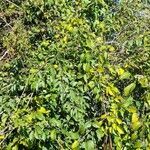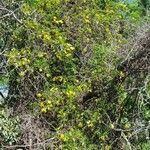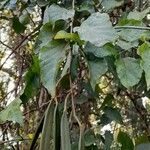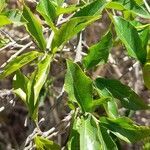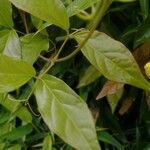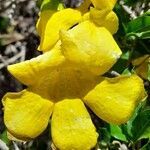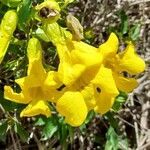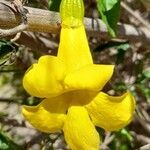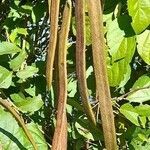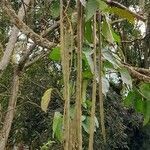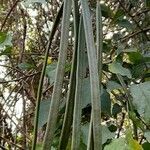Liana to 6 cm in diameter, the bark dark, fibrous, irregularly striate; attached to supporting tree by adventitious rootlets; phloem of stem irregularly many-armed in cross section; dimorphic, the juvenile plant with small leaflets, 1-2 cm long and 4-8 mm wide, climbing straight up tree trunks, often rooting at nodes; branchlets terete, puberulous to glabrous, the nodes usually without interpetiolar glandular fields; pseudostipules ovate, longitudinally striate. Leaves 2-foliolate, often with a trifid uncate tendril especially when young; leaflets when young narrowly ovate to lanceolate, mucronate at tip, basally rounded, when mature narrowly ovate to ovate, acute to acuminate, cuneate to truncate, 5.0-16 cm long and 1.2-6.9 cm wide, membranaceous, scattered lepidote above and beneath, otherwise glabrous above and beneath, or sparsely puberulous especially along main veins or rarely densely puberulous over whole under surface, a few plate-shaped glands near midvein beneath, drying dark green or dark olive to almost black, the main veins drying reddish below; mature petiolules 0.8-3.5 cm long, petiole 1.1-6 cm long, glabrous or subpuberulous. Inflorescence an axillary panicle usually reduced to 1 or 3 flowers, rarely to 15 flowers, the branches more or less glabrous. Flowers with the calyx membranaceous, cupular with a sinuous margin, subtruncate, glabrous to slightly lepidote, often with scattered glands, 5-18 mm long and 8-18 mm wide; corolla yellow with ca 9 orange lines in the throat, tubular-campanulate, 4.5-10 cm long and 1.2-2.4 cm wide at mouth of tube, the tube 3.3-6.9 cm long, the lobes 1.2-3.1 cm long, glabrous outside, glabrous or slightly simple puberulous along throat ridges inside, pubescent with simple jointed trichomes at the level of stamen insertion; stamens didynamous, the anther thecae divaricate, 3 mm long, the filaments 1.2-2.4 cm long, the staminode 0.5-1.5 cm long, occasionally developed into fifth stamen, insertion 4-8 mm above base of corolla tube; pistil 2.8-3.8 cm long, the ovary linear, 6-7 mm long and 1.2 mm wide, minutely lepidote to subpuberulous, the ovules 4-seriate but appearing 2-seriate in most cross sections; disc annular, 1-1.5 mm long and 3-4 mm wide. Capsule elongate-linear, tapering at the ends, flattened, 26-95 cm long and 1.0-1.9 cm wide, the surface inconspicuously lepidote, drying blackish with small whitish lenticels, midrib not raised; seeds 1.0-1.8 cm long and 4.2-5.8 cm wide, the wings membranaceous, blunt-ended, mostly brown, the extreme tips irregularly hyaline, not sharply demarcated from seed body.
More
Vigorous woody climber, climbing by tripartite, hooked (uncinate) tendrils (resembling claws) and adventitious roots and tubers, glabrous. Leaves opposite, 3-foliate with the terminal leaflet modified into a 3-clawed tendril, each claw c. 10–15 mm long (tendrils absent from some leaves); leaflets usually 2 (rarely 1 or 5 in juveniles), with lamina ovate to oblong-elliptic, 2–7 cm long, 10–30 (–35) mm wide, glabrous, apex ± acuminate, margin entire to obscurely toothed; petiole 10–20 cm long; petiolules (1.5–) 5–15 mm long. Panicles axillary, sometimes reduced to 1 or 3 flowers. Flowers: calyx c. 10–15 (–20) mm long; corolla yellow often with darker or orangey lines in tube, 4–8 (–9) cm long, lobes to c. 2 cm long, ± white-ciliate margin. Stamens dimorphic, 2 long and 2 short and 1 staminode. Capsule linear, 15–47 cm long, 8–13 (–20) mm wide, leathery, ± smooth; seeds numerous, 20–40 × 9–12 mm (including wing), appearing 2-winged as membranous, ± hyaline wing wider at 2 ends.
A creeper. It has root tubers 3-4 cm across. The leaves have 2-3 leaflets.
